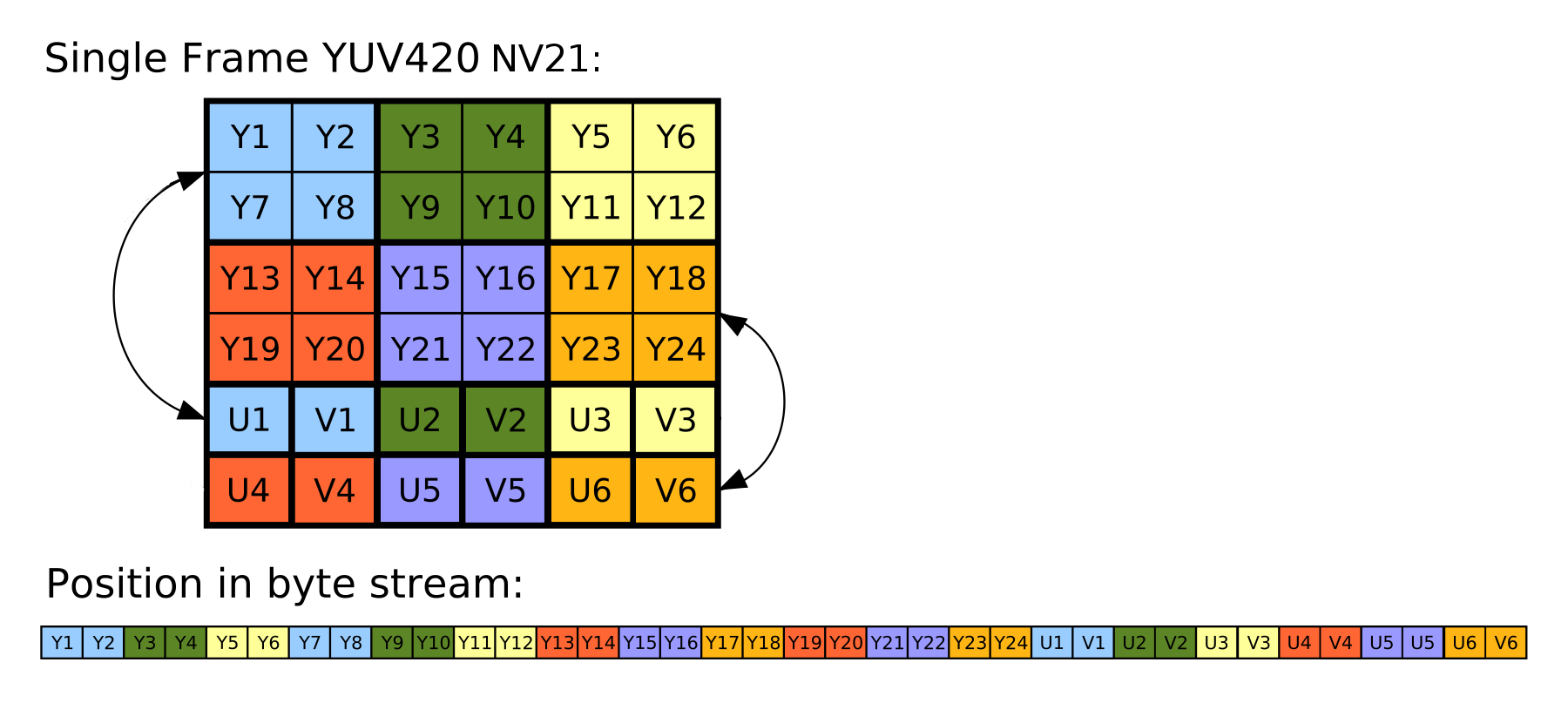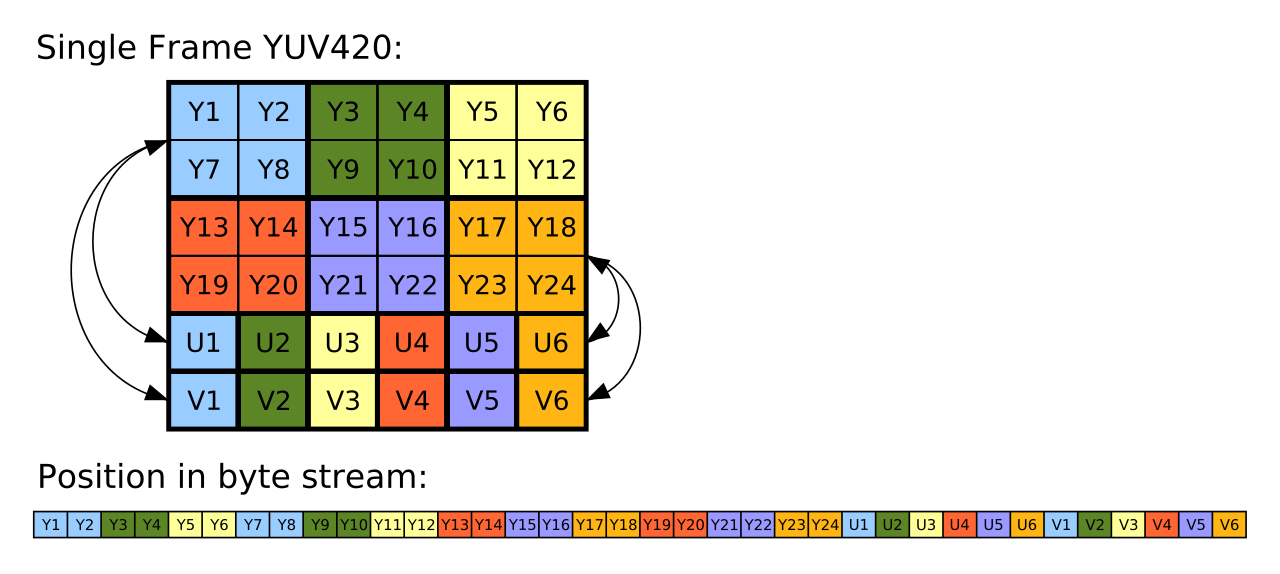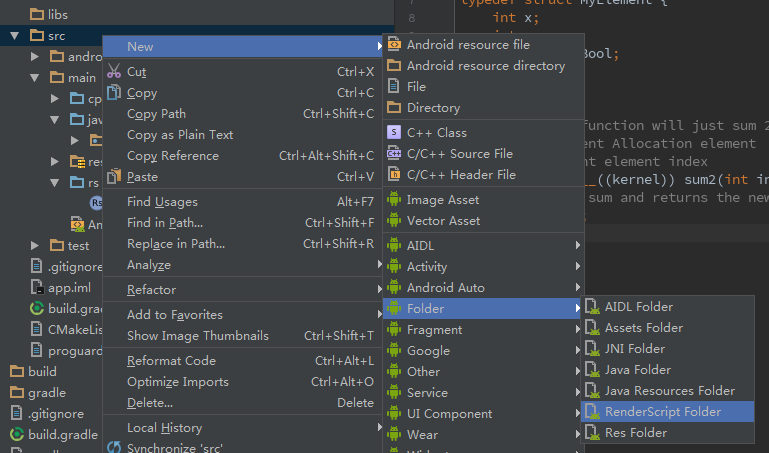Android5.0发布后,随着Camera2的兼容性不断提升,目前完全可以替代旧API的使用。而Camera2在调用方法、相机设置、图片获取等方面都变化很大。
在实时预览图像获取时,通用的图片格式由 YUV_NV21 变为 YUV_420_888 ,因此在转换为Bitmap时出现了问题,由于Google并没有直接提供YUV2RGB的方法,因此网上代码鱼龙混杂,本文总结了几个高效的转换方法。
//Camera API
public void onPreviewFrame(byte[] data, Camera camera){
YuvImage image = new YuvImage(data, ImageFormat.NV21, size.width, size.height, null);
}
//Camera2 API
public void onImageAvailable(ImageReader reader){
Image image = reader.acquireLatestImage();
}
原理


可以看出NV21和YUV很相似,因此由NV21[/latex]gt;RGB的时间与YUV[/latex]gt;RGB的时间相似。
JAVA直接转码
该方法实现简单,处理640×480预览图平均时间为33ms
public void onImageAvailable(ImageReader reader) {
Image image = reader.acquireLatestImage();
if (image == null) return;
ByteArrayOutputStream outputbytes = new ByteArrayOutputStream();
ByteBuffer bufferY = image.getPlanes()[0].getBuffer();
byte[] data0 = new byte[bufferY.remaining()];
bufferY.get(data0);
ByteBuffer bufferU = image.getPlanes()[1].getBuffer();
byte[] data1 = new byte[bufferU.remaining()];
bufferU.get(data1);
ByteBuffer bufferV = image.getPlanes()[2].getBuffer();
byte[] data2 = new byte[bufferV.remaining()];
bufferV.get(data2);
try {
outputbytes.write(data0);
outputbytes.write(data2);
outputbytes.write(data1);
} catch (IOException e) {
e.printStackTrace();
}
final YuvImage yuvImage = new YuvImage(outputbytes.toByteArray(), ImageFormat.NV21, image.getWidth(),image.getHeight(), null);
ByteArrayOutputStream outBitmap = new ByteArrayOutputStream();
yuvImage.compressToJpeg(new Rect(0, 0, image.getWidth(), image.getHeight()), 95, outBitmap);
Bitmap bitmap = BitmapFactory.decodeByteArray(outBitmap.toByteArray(), 0, outBitmap.size());
image.close();
}
NDK方法
从理论上来说用c运算的效率会比java高,处理640×480预览图平均时间为24ms
代码详见我的Github
public void onImageAvailable(ImageReader reader) {
Image image = reader.acquireLatestImage();
Image.Plane[] plane = image.getPlanes();
byte[][] mYUVBytes = new byte[plane.length][];
for (int i = 0; i < plane.length; ++i) {
mYUVBytes[i] = new byte[plane[i].getBuffer().capacity()];
}
int[] mRGBBytes = new int[640 * 480];
for (int i = 0; i < plane.length; ++i) {
plane[i].getBuffer().get(mYUVBytes[i]);
}
final int yRowStride = plane[0].getRowStride();
final int uvRowStride = plane[1].getRowStride();
final int uvPixelStride = plane[1].getPixelStride();
ImageConvert.convertYUV420ToARGB8888(
mYUVBytes[0],
mYUVBytes[1],
mYUVBytes[2],
mRGBBytes,
image.getWidth(),
image.getHeight(),
yRowStride,
uvRowStride,
uvPixelStride,
false);
Bitmap mRGBframeBitmap = Bitmap.createBitmap(image.getWidth(), image.getHeight(), Bitmap.Config.ARGB_8888);
mRGBframeBitmap.setPixels(mRGBBytes, 0, image.getWidth(), 0, 0, image.getWidth(), image.getHeight());
image.close();
}
RenderScript方法
RenderScript、OpenGL、ndk是安卓下三大加速法宝,RenderScript运算的效率应介于java和ndk之间,处理640×480预览图平均时间为26ms
1.修改app的build文件
defaultConfig {
applicationId "..."
minSdkVersion 21
targetSdkVersion 26
versionCode 1
versionName "1.0"
testInstrumentationRunner "android.support.test.runner.AndroidJUnitRunner"
**renderscriptTargetApi 19**
**renderscriptSupportModeEnabled true**
}2.创建RenderScript文件夹
工程列表[/latex]gt;app[/latex]gt;右键[/latex]gt;New[/latex]gt;Folder[/latex]gt;RenderScript Folder
3.建立rs文件 yuv420888.rs
#pragma version(1)
#pragma rs java_package_name(me.immi.mycare);
#pragma rs_fp_relaxed
int32_t width;
int32_t height;
uint picWidth, uvPixelStride, uvRowStride ;
rs_allocation ypsIn,uIn,vIn;
// The LaunchOptions ensure that the Kernel does not enter the padding zone of Y, so yRowStride can be ignored WITHIN the Kernel.
uchar4 __attribute__((kernel)) doConvert(uint32_t x, uint32_t y) {
// index for accessing the uIn's and vIn's
uint uvIndex= uvPixelStride * (x/2) + uvRowStride*(y/2);
// get the y,u,v values
uchar yps= rsGetElementAt_uchar(ypsIn, x, y);
uchar u= rsGetElementAt_uchar(uIn, uvIndex);
uchar v= rsGetElementAt_uchar(vIn, uvIndex);
// calc argb
int4 argb;
argb.r = yps + v * 1436 / 1024 - 179;
argb.g = yps -u * 46549 / 131072 + 44 -v * 93604 / 131072 + 91;
argb.b = yps +u * 1814 / 1024 - 227;
argb.a = 255;
uchar4 out = convert_uchar4(clamp(argb, 0, 255));
return out;
}4.rebuild项目
5.YUV_420_888_toRGB8888方法
public static Bitmap YUV_420_888_toRGB8888(Context context, Image.Plane[] planes, byte[][] yuvBytes, int width, int height){
int yRowStride= planes[0].getRowStride();
int uvRowStride= planes[1].getRowStride(); // we know from documentation that RowStride is the same for u and v.
int uvPixelStride= planes[1].getPixelStride(); // we know from documentation that PixelStride is the same for u and v.
RenderScript rs = RenderScript.create(context);
ScriptC_yuv420888 mYuv420=new ScriptC_yuv420888(rs);
Type.Builder typeUcharY = new Type.Builder(rs, Element.U8(rs));
typeUcharY.setX(yRowStride).setY(height);
Allocation yAlloc = Allocation.createTyped(rs, typeUcharY.create());
yAlloc.copyFrom(yuvBytes[0]);
mYuv420.set_ypsIn(yAlloc);
Type.Builder typeUcharUV = new Type.Builder(rs, Element.U8(rs));
typeUcharUV.setX(yuvBytes[1].length);
Allocation uAlloc = Allocation.createTyped(rs, typeUcharUV.create());
uAlloc.copyFrom(yuvBytes[1]);
mYuv420.set_uIn(uAlloc);
Allocation vAlloc = Allocation.createTyped(rs, typeUcharUV.create());
vAlloc.copyFrom(yuvBytes[2]);
mYuv420.set_vIn(vAlloc);
// handover parameters
mYuv420.set_picWidth(width);
mYuv420.set_uvRowStride (uvRowStride);
mYuv420.set_uvPixelStride (uvPixelStride);
Bitmap outBitmap = Bitmap.createBitmap(width, height, Bitmap.Config.ARGB_8888);
Allocation outAlloc = Allocation.createFromBitmap(rs, outBitmap, Allocation.MipmapControl.MIPMAP_NONE, Allocation.USAGE_SCRIPT);
Script.LaunchOptions lo = new Script.LaunchOptions();
lo.setX(0, width); // by this we ignore the y’s padding zone, i.e. the right side of x between width and yRowStride
lo.setY(0, height);
mYuv420.forEach_doConvert(outAlloc,lo);
outAlloc.copyTo(outBitmap);
return outBitmap;
}6.使用示例
public void onImageAvailable(ImageReader reader) {
Image image = reader.acquireLatestImage();
Image.Plane[] planes = image.getPlanes();
for (int i = 0; i < planes.length; ++i) {
final ByteBuffer buffer = planes[i].getBuffer();
if (yuvBytes[i] == null) {
yuvBytes[i] = new byte[buffer.capacity()];
}
buffer.get(yuvBytes[i]);
}
Bitmap processBitmap = UtilImage.YUV_420_888_toRGB8888(MainActivity.this,planes,yuvBytes,640,480);
image.close();
}其他方法
还有一些其他的转换方法,效率与上面类似,不再细说
![[工具]希腊字母读法](https://blog.mclover.cn/wp-content/themes/slanted/img/thumb-medium.png)
厉害了
RenderScript 方法中yAlloc.copyFrom(yuvBytes[0]);这句报错android.support.v8.renderscript.RSIllegalArgumentException: Array too small for allocation type
so库方法:public static native void convertYUV420ToARGB8888 这个方法报红,而且生成的版本不全
RenderScript 错误请检查你传入的参数是否正确
so库方法需要as项目支持nkd(目前as默认cmake了需要手动修改),ndk方法默认都是红的
感谢及时回复!onImageAvailable回调中yuvBytes[]这个怎么来的?是这样byte[][] yuvBytes = new byte[planes.length][];定义的吗?
yuvBytes[]这个还是太明白哪儿来的
在RenderScript方法的onImageAvailable函数中,yuvBytes只是一个全局变量,定义方式为byte[][] yuvBytes = new byte[3][];
目前用android.renderscript,不是android.support.v8.renderscript,转出来是图片结果,图片上半部正常显示,下半部分绿色一片,这是为什么?
在文章“6.使用示例”中有yuvBytes[]的代码,代码已经多次部署,100%靠谱的
NDK方案和renderscript方案是否能添加 旋转 的功能接口,我是转换出来生成bitmap,发现前置摄像头的图片位置偏差90°